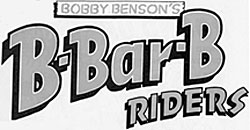

 by Boyd Magers Over the thunderous hoofbeats opening, the announcer reveled, “Here they come! They‘re riding fast and they’re riding hard! It’s time for action and adventure in the modern West with Bobby Benson and the B-Bar-B Riders! And out in front, astride his golden palomino Amigo, it’s the cowboy kid himself, Bobby Benson! BEEE-BAR-BEEEE!”
The show was an immediate hit and spawned premiums like cereal bowls, code books, drinking tumblers, badges, neckerchiefs, a give-away comic book, “…In the Tunnel of Gold”, cap guns, card games, H-O Rangers in Africa 19x25" map, cast photos, bracelets and, of course, several variations of the “H-Bar-O News”. The show was broadcast three times a week at 5pm. After the first season of 78 episodes ended in March ‘33, for technical reasons CBS moved production of the show to New York City and it was now on five times a week at 6 or 6:15pm. The cast now featured Billy Halop (later of the Dead End Kids) as Bobby. Halop’s younger sister Florence played Polly Armstead. Tex Mason was now voiced by Neil O’Malley. Sidekick humor was provided by Windy Wales (played by various actors). Craig McDonnell played Harka, an Indian ranch hand. An 18 year old Bert Parks was also in the cast.
Bobby’s radio adventures continued for another 16 months until it was cancelled on December 11, 1936. It’s unknown who played Bobby during that time. By 1949 Herbert Rice was now VP in charge of programming at Mutual. When the network needed an afternoon kids’ show, Rice revived Bobby as a half hour three to five times a week series that began on June 21, 1949, with a slight     In early ‘51 Curry left “Benson” for “Portia Faces Life” and Robert J. McKnight briefly became the next Bobby Benson. Herb Rice’s nephew, 10 year old Clive Rice under the professional name Clyde Campbell, became the Cowboy Kid through the end of the series run on June 17, 1955. Rice/Campbell, Don Knotts as Windy and Tex Fletcher (who had starred in one B-Western film, “Six Gun Rhythm” in ‘39) as Tex Mason appeared in person at various state fairs in the ‘50s. A good show that entertained radio audiences over three decades. (Some art spots by Bobb Lynes.)
|
|